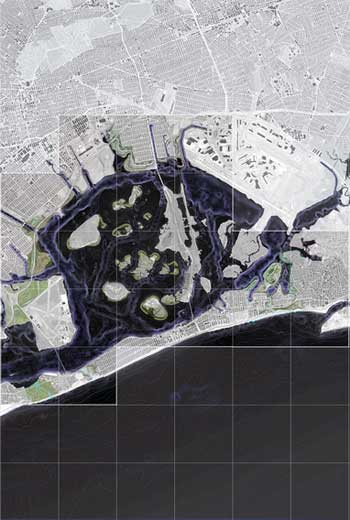STORMPROOFING THE ATLANTIC COAST
The galleries of the Center for Architecture in New York City provide a small view of the large scope of the Structures of Coastal Resilience, a new research and design project from Princeton University. The project is sweeping: new designs for resilience on the Atlantic coastline from New England to Virginia. The exhibition displays just two proposals for Atlantic City, New Jersey, and New York’s Jamaica Bay, but the in-depth, companion web site shows all four proposals, including those for Narragansett Bay, Rhode Island, and Norfolk, Virginia. The straightforward exhibition design — mostly architectural boards pinned to the wall — details solutions for buffering against storms in the next hundred years.
A team from Princeton University’s School of Architecture led by architecture professor Paul Lewis, also a principal at Lewis.Tsurumaki.Lewis (LTL) Architects, proposes to storm-proof a suburban neighborhood of Atlantic City by creating “amphibious suburbs,” elevating road and houses and softening edges between private yards and wetlands (see image above).
The strategies proposed by a team from the City College of New York, led by landscape architecture professor Catherine Seavitt, ASLA, similarly raise roads and form berms to protect bay front settlements in Jamaica Bay, New York, while focusing on urban ecology to restore marshes and improve water flow through the Bay.
The Jamaica Bay team broke down its analysis into a series of booklets on display, from a catalog of resident fauna to a history of infrastructural interventions. Unfortunately, the most captivating element of their work is not on view. A series of topographical models of Jamaica Bay cast in soap are a missed opportunity to take advantage of the physical exhibition space to understand the area in question and the modeling processes behind the design proposals. See a few brief videos:
The project’s website provides a better introduction to the design proposals. A team led by landscape architecture professors Michael Van Valkenburgh, FASLA, and Rosetta Elkin at Harvard University Graduate School of Design examines how best to add redundancy to the storm protection capabilities of coastal forests and shrub lands in Rhode Island’s Narragansett Bay.
And a team lead by landscape architecture professor Anuradha Mathur, ASLA, and architect and planner Dilip da Cunha at the University of Pennsylvania proposes “fingers of high ground” for refuge and new settlements in the tidewaters of Norfolk, Virginia.
These complex and rigorously-scientific proposals have been far less publicized than the work of the other major design research projects prompted by the devastation of Hurricane Sandy in 2012. The winners of the Rebuild by Design competition are now in the planning phases for pilot projects supported by the U.S. department of Housing and Urban Development (HUD).
The projects of Structures of Coastal Resilience focus on less densely populated landscapes, with the goal of developing recommendations for ongoing projects by the U.S. Army Corps of Engineers. As a result, they appear far less engaged with the human and political dimensions of adaptation to climate change. However, there is more than ecological modeling and housing prototypes to the wholesale transformation of a residential neighborhood. Amphibious suburbs are a response to the political impossibility of total retreat from the sea, but elevating homes and redefining boundaries of public and private space begs discussion, too.
Exhibitions are a great vehicle for bringing such questions to the public sphere, but, for that, they need to speak in a language more compelling than that of the architectural studio.
Structures of Coastal Resilience is on view at the Center for Architecture in New York City through April 2, 2016.
This guest post is by Mariana Mogilevich, a historian of architecture and urbanism, whose research focuses on the design and politics of the public realm.











Follow Us!